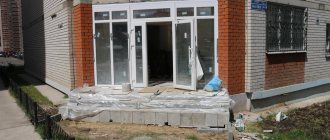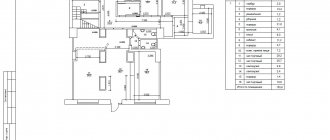How to divide a room or building into two separate parts?
Non-residential premises or a building can be divided into several parts if they are in shared ownership (Article 244 of the Civil Code of the Russian Federation). According to the legislation of the Russian Federation, such a division is possible if one of the following conditions is met:
- All owners of this property have provided voluntary consent to the division in writing and notarized.
- The division is carried out through the courts.
In addition to the Civil Code of the Russian Federation, the division of real estate is regulated by the Federal Law “On State Registration of Real Estate” dated July 13, 2015 No. 218-FZ.
Terms and costs of the section
In order to carry out construction work and legalize the division, you need to go through the stage of design, project approval, acceptance of work, and preparation of a technical plan. Only based on the results of these procedures can rights to newly created objects be registered. When determining the duration of each listed stage, the following requirements must be taken into account:
- the lead time for a redevelopment or reconstruction project depends on the complexity and volume of work, as well as on the qualifications and professionalism of the expert organization’s specialists (for example, contact, you can receive a redevelopment project within a few days);
- approval of redevelopment should not exceed 45 days, and correct execution of project documentation will allow you to complete this procedure the first time;
- a construction permit is issued by a supervisory authority, and the period for document verification can reach 2-3 months;
- after construction work has been completed and accepted, drawing up a technical plan will take from 1 day to several weeks (specialists will complete this work in 1-2 days, and in the most difficult situations no later than 5 days).
According to the rules of Federal Law No. 218-FZ, cadastral registration and registration activities are carried out within the framework of one procedure. It will take 10 days. If the documents are sent immediately to Rosreestr, or 12 days when applying through the MFC.
Why is this procedure necessary?
The division of a non-residential property into several parts implies the implementation of this process at the legislative level, so that as a result, for each allocated part, you receive a certificate of ownership and a separate cadastral number. The need for such a section arises when the following transactions are to be made:
- purchase and sale;
- rent;
- sublease;
- conclusion of a mortgage agreement.
Important! When dividing, the number of parts does not matter. A non-residential property can be divided into as many parts as necessary.
Requirements for dividing premises
Confirmation of signs of isolation and isolation is of key importance when registering rights to newly created premises. Here are the nuances that characterize the definition of these signs:
- when isolated, each newly created room is limited from the rest of the building with a separate entrance;
- isolation consists not only of a similar restriction, but also of the presence of access to the common areas of the building, or to the street.
The limitation occurs due to the arrangement of walls or partitions, including load-bearing elements of the building (walls, ceilings, ceilings, etc.). If a room has two or more exits, it cannot be considered isolated (the exception is when all but one exit leads to auxiliary premises).
For the division, the existing boundary structures of the original object will be used, as well as newly constructed walls and partitions. All this work must comply with design documentation, which can be drawn up by an expert organization with SRO approval. If the non-residential premises to be divided are located in a multi-apartment residential building, in addition to the project, a technical report on the condition of the load-bearing structures is drawn up.
The emergence of new premises implies mandatory consideration of their characteristics. To do this, after completion of the work and its acceptance, the owner turns to the cadastral engineer to draw up a technical plan. The technical plan is prepared according to the following rules:
- the engineer requests information from the Unified State Register of Real Estate in relation to the building, the original premises and adjacent objects;
- a survey of newly created objects is carried out in situ (if the engineer establishes deviations from the design documentation, he is obliged to reflect these facts in his conclusion);
- the location of new premises is reflected on the floor plan of the building, including their boundaries;
- the parameters of each new room are described in text and graphic form, and the contents of the technical plan include diagrams and drawings.
Thus, based on the results of the section, technical plans are drawn up for each new premises, as well as for the building itself, since its characteristics have changed as a result of construction work.
The technical plan for each facility is sent to Rosreestr or MFC - accounting and registration procedures will be carried out, as a result of which:
- information about the original premises will be excluded from the Unified State Register of Real Estate, and its cadastral number will be cancelled;
- new objects will be registered, their information will be transferred from technical plans to the Unified State Register of Real Estate, and at the same time rights will be registered;
- the owner will receive an extract from the Unified State Register of Real Estate for each object, reflecting the characteristics and information about registered rights.
If construction work under the section is not initially approved by the authorized authorities, accounting and registration activities will end with a decision to suspend, and then refuse.
Expert commentary . Will erecting a partition in a room be considered partition? It is almost impossible to determine this without the help of a professional expert and designer - the concepts of isolation and isolation have similar characteristics. Therefore, when planning a division of the premises, seek help from specialists - we have experience in preparing documentation for even the most complex objects.
Step-by-step instruction
Where to contact?
There is a certain sequence of actions:
- The first step (in the case when everything happens on a voluntary basis) is to draw up a special document - “Agreement on the division of non-residential premises.” This document describes in detail how the premises will be divided and the conditions of this process.
- Then you need to contact the BTI and call a technician, who, after inspecting the premises and taking measurements, will produce new technical plans and technical passports for each selected part.
- Order cadastral extracts from Rosreestr.
- Apply with a complete package of documents to the local branch of Rosreestr.
If there is no way to voluntarily divide the non-residential premises, or it is not possible to reach an agreement by mutual consent, then you will have to go to court in order to forcefully divide the real estate in the future. Then, on the basis of a court ruling, it will be possible to apply to the BTI.
Documentation
To complete the division procedure, the following documents will be required (provided for by Federal Law No. 218-FZ):
- An application to Rosreestr, which must contain a request to terminate the right of common shared ownership of this non-residential premises and to register individual ownership for each part (in accordance with technical passports). All owners sign the application.
- Agreement on division of premises.
- Title documents for this (original) object.
- Technical and cadastral documents for the original object.
- Extract from the Unified State Register of Real Estate.
- Technical documentation for new objects (parts of non-residential premises).
- Copies of passports (of all applicants).
- Receipts for payment of state duty (separate for each part).
What are the financial expenses?
The following expenses will be incurred:
- Payment of the state fee for registration of property rights is 2 or 22 thousand rubles, depending on whether the applicant is an individual or a legal entity.
- Payment of the state fee for registration of property rights is 2 thousand rubles (from an individual) or 22 thousand rubles (from a legal entity).
- Payment of the state duty for the production of a technical passport is 1200 rubles (if required urgently, then 2.5 thousand rubles).
How long should I wait for an answer?
- After contacting Rosreestr, new documents confirming ownership will be issued within seven working days.
- If the application is made through the MFC, the documents will be ready in nine working days.
What is given at the end of the procedure?
Attention! A non-residential premises that has been divided into two separate ones loses its cadastral number and all information about it is excluded from the Unified State Register of Real Estate.
At the end of the procedure, the owners (each for their allocated part) receive:
- Separate cadastral numbers (how the number of non-residential premises is assigned during cadastral registration is written here).
- Extracts from the Unified State Register of Real Estate, which reflect information about the new premises that were formed as a result of the division and about the owner (certificates of ownership are not currently issued).
The division is considered completed once the rights of each owner are registered. Simultaneously with the cadastral registration of new objects, registration actions must also be carried out.
It is worth remembering that after dividing the premises into parts, the rights of shared ownership are retained (Article 250 of the Civil Code of the Russian Federation). Based on this, each co-owner has the right of first refusal in the event of the sale of one of the shares.
Premises section
Partitioning a room is an operation during which it becomes possible to create two or more new rooms, each of which will be assigned its own parameters.
The newly created premises must have the necessary signs of isolation and isolation. The absence of the last two signs is recognized as a legal basis for suspending and/or prohibiting actions related to registration (clause 34, part 1, article 26 of the Federal Law No. 218-FZ). The procedure for dividing a room has several important features:
- the decision to carry out a division can only be made by the owner, and if there are several rights holders, it is impossible to do without obtaining the consent of each of them;
- the division is carried out during construction work that falls under the concept of redevelopment or reconstruction;
- redevelopment and reconstruction is impossible without prior approval - its implementation is possible only on the basis of project documentation. If the question of reconstruction arises, you will need to obtain a permit for reconstruction. We wrote in detail about how to issue a notification and obtain permission for construction or reconstruction here https://prokadastr.com/kak-zaregistrirovat-dom/;
- the results are approved in the construction work report. After approval, the results are recorded in a technical plan, drawn up by a cadastral engineer (he begins this task only after he personally inspects the newly created premises).
The emergence of new premises implies mandatory recording of their characteristics and mandatory entry of information into the Unified State Register of Real Estate.
Grounds for separation
There are only two grounds for dividing non-residential premises: a voluntary decision of the owner (owners) and a court order.
The owner's consent is drawn up in writing by a notary. If there are two or more owners, written confirmation of the consent of each of them is required.
By court decision, division is carried out if the owner refuses to carry out this procedure, although he is obliged to do it. Example: non-residential premises are part of the inheritance and must be divided among the heirs. But there is no will, and the heirs have disagreements. In such a situation, the division of non-residential premises is carried out by court decision.
Reasons for refusal
In some cases, the responsible authorities do not allow the division of real estate into independent objects. In such a situation, the owner of the shared property needs to become familiar with the reasons for the refusal. The prohibition is always made in writing. The received document details the reason why the division of real estate cannot be carried out. In this case, a number of actions should be taken:
- Please read the submitted disclaimer carefully. The document must list the existing shortcomings associated with the division of the property.
- Eliminate the listed shortcomings, if they really exist.
- Resubmit documents for partition.
Errors must be corrected within 90 days. If the owner does not have time to eliminate the shortcomings, then he may, in principle, be prohibited from dividing the property. In such a situation, the case will have to be resolved through court, without guarantees of a positive outcome.
Owners wishing to carry out a division of real estate must remember the main reasons for refusing this procedure:
- The property does not meet the requirements for division - it is not isolated or separate. Example: halls in a shopping center, if there are several exits, cannot be divided until reconstruction.
- The objects formed during the division do not meet the basic requirements: no access to water, electricity, sewerage, no natural light, are not isolated, area less than 12 square meters.
- There is a difference between the data available in the Unified State Register of Real Estate and the actual characteristics of the property. Any difference in the data on an object is considered grounds for refusal. Example: the area is 0.5 square meters larger (or smaller).
- The person who submitted the application for redevelopment does not have the right to file an application with the Unified State Register of Real Estate.
- There are errors in the completed documentation. An important point: the document may not be accepted even due to illegible handwriting or blots.
- There is no required documentation, for example, confirming ownership of the property involved in the division.
- This premises cannot be divided due to a seizure or ban.
If the reason is not specified, or, in the owner’s opinion, is far-fetched, it is recommended to go to court. But lawyers emphasize: it is advisable to first talk with the person in charge who made the decision on the issue of division of real estate. If an agreement cannot be reached, recourse to the courts becomes the only possible way out.
Sources
- https://prokadastr.com/razdel-i-vydel-pomeshhenij/
- https://o-nedvizhke.ru/kommercheskaya-nedvizhimost/mozhno-li-i-kak-razdelit-nezhiloe-pomeshhenie-na-dva-pomeshheniya.html
- https://leonmonitor.ru/kak-razdelit-nezhiloe-pomeshhenie-na-dva-otdelnyh/
- https://urexpert.online/nedvizhimost/nezhilaya/razdelit-pomeshhenie.html
- https://ahrfn.com/pereplanirovka/kak-razdelit-nezhiloe-pomeshhenie-na-dva-otdelnyx.html
[collapse]
Conditions of separation
There are two main requirements that the shared premises must meet - isolation and isolation of the property:
- Isolation exists when there are four walls (with or without windows) and a separate entrance. Walls cannot be replaced with temporary partitions: they must be permanent and permanent. And there should be only one entrance. If there are two or more entrances, then the property is no longer considered isolated.
- Isolation - the presence of a separate entrance to public places: to the entrance of a house, to the street, etc.
If these requirements are not met, the room cannot be divided. In certain situations, you will have to carry out redevelopment: remove or add additional exits, install walls, etc.
It is desirable that the base room can be used for its intended purpose. Example: the premises are considered a warehouse, but due to unauthorized redevelopment, they cannot be used for storing certain products. In such a situation, the Unified State Register of Real Estate has the right not to issue permission for division.
The created real estate objects must also meet a number of requirements:
- Natural light sources are available - that is, there are windows. They must provide sufficient lighting during daylight hours.
- Electricity and heating are provided, there is access to water and sewerage.
- The room meets the minimum area requirements - at least 12 square meters.
Requirements for allocating premises
When allocating premises, the following requirements must be met:
- the original object will change its characteristics, but will retain the same cadastral number;
- the newly created object will not only acquire a list of unique characteristics, but will also receive a cadastral number after registration with Rosreestr;
- like the division of premises, the allocation can be carried out as a result of redevelopment or reconstruction, i.e. all changes in real estate must be taken into account in the project and agreed upon by the authorized authorities;
- if the selected object has signs of isolation and isolation, it will be put on permanent cadastral registration - otherwise we can only talk about temporary cadastral registration.
Thus, in order to agree on the allocation of premises, the owner must order a project, obtain a technical opinion, and contact a cadastral engineer to draw up a technical plan. If there is a temporary allocation of premises, there is no need to order and approve design documentation.
Expert commentary . The procedure for preparing project documentation and its approval is practically no different when dividing and allocating premises. However, the consequences of these two options are directly related to the fate of the original object - when divided, it ceases to exist in kind, and when separated, it is preserved in a modified form.
Recommendations for former spouses when dividing an apartment
To avoid controversial situations, we will briefly formulate a few simple recommendations. Following which, you can minimize conflict situations as much as possible.
Voluntary mutual agreement in notarial form
The voluntary consent of the spouses will allow the division of a joint apartment after a divorce. The advantage of a mutual agreement on the division of property is the absence of financial and moral costs and the possibility of a calm division of housing without further personal clarification.
This is possible only if there is peace and complete agreement between the former spouses. Otherwise you have to go to court. The notarial form of the agreement will not allow either party to refuse the assumed obligations.
However, if there are compelling reasons, this document can be challenged in court.
Official registration of the marriage contract
This method will make it possible to provide for the voluntary division of property and the procedure for its use even before the divorce on conditions that satisfy both parties.
At the same time, it is important to take into account the interests of the spouses in the marriage contract.











